![]()
![]()
![]()
Use LEFT and RIGHT arrow keys to navigate between flashcards;
Use UP and DOWN arrow keys to flip the card;
H to show hint;
A reads text to speech;
23 Cards in this Set
- Front
- Back

|
Name: Volonté de Puissance (Will to Power Artist: Jean Dubuffet Year: 1946 Description: This piece by Dubuffet is characteristic of Art Brut. in this piece, Dubuffet ignores traditional French tradition in exchange for a more primitive style, inspired by works of art by the mentally ill and grafitti. There is a specific attention paid to the materiality of the piece as it has glass, rope, sand, and pebbles in it, creating a tension indicative of the flatness of a painted work. It's title is take from Nietze and became popular amongst nazis. There is a primitivism and an idea of a rising from the mud. |
|
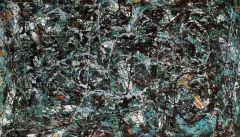
|
Name: Full Fathom Five Artist: Jackson Pollock Year: 1947 Description: There is a tension in the painting brought forth between control Pollock exhibits over the piece and simultaneous gap that gives potency to chance in the way of Hans Arp. This piece shows a nod to an appreciation of new techniques in the horizontal painting. The rough texture of the painting shows a growing tension of the flatness of the medium of painting. The integration of items like nails, cigarette butts, and other untraditional materials also gives reference to the title, which is drawn from a quote about a shipwreck in Shakespeare's, The Tempest. |
|
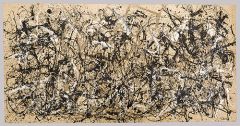
|
Name: Autumn Rhythm Artist: Jackson Pollock Year: 1950 Description: Pollock made a skeleton painting of his piece on the unprimed canvas of this piece, thus linking the structure of the piece to the actual painting. On top, he did his signature horizontal painting that held a perceived randomness in nature. The horizontal nature and freeness of the brushstrokes seem to relate back to the title. |
|
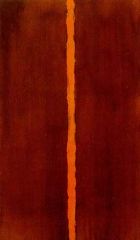
|
Name: Onement I Artist: Barnett Newman Year: 1948 Description: This is a piece done in an autobiographical/ abstract expressionist style. It is an expansive field of color that is interrupted by a "zip" represented by a vertical line that is done my masking tape. This "zip" simultaneously divides and unifies the canvas as a whole. The insistent verticality and bilateral symmetry emphasize and anthropomorphic quality that cannot be shaken. |
|
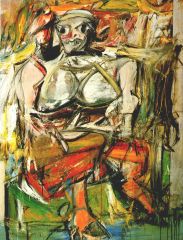
|
Name: Woman I Artist: Willem de Kooning Year: 1950-52 Description: This piece defines de Kooning as an abstract expressionist. It's brass and large brushstrokes give the piece an inherent violence, as if the woman has been mistreated in her formation. The woman is relatively primitive in her depiction, reminiscent of a Venus fertility statue. This femininity and rough depiction seem to beg for a complimentary male counterpart which could be taken on by the artist himself. |
|
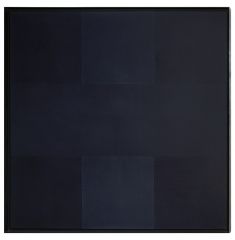
|
Name: Abstract Painting, Black Artist: Ad Reinhardt Year: 1957 Description: This piece shows how engaged Reinhardt was with abstract art and how much of an influence he had on minimalism. The piece is comprised of multiple black squares that make up a larger composition. The unit and wholeness are in constant relation to one and other, and the piece is fundamentally non-compositional. This affects the narrative of the gaze. |
|

|
Name: Rebus Artist: Robert Rauschenberg Year: 1955 Description: This piece could be called a Combine, a term coined by Johns in which there is a "painting playing the game of sculpture". This piece emphasizes painting as a readymade, as everyday life is rearranged to create a cohesive piece. It reflects the business and chaos of a work desk. |
|
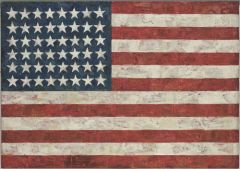
|
Name: Flag Artist: Jasper Johns Year: 1954/55 Description: This piece by Johns affirms his role as an artist occupying the middle ground between pop art and abstract expressionism. His lean towards popular culture in using graphic, familiar images like the American flag seems to suggest a nod to pop art, while his use of encaustic, three panels, and the piece's overall inability to be defined as a painting or sculpture keep it in the realm of abstract expressionism. |
|
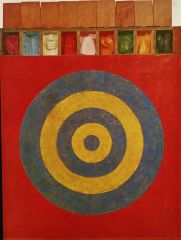
|
Name: Target with Plaster Casts Artist: Jasper Johns Year: 1955 Description: This piece also affirms Johns as an artist who resides between pop art and abstract expressionism. There is a graphicness to his piece that leans towards the pop art movement. The use of primary colors and a familiar subject augments this. However a tension arises as though he uses familiar images such as a target and body parts, the body's severing and the target's unique materiality take it out of the realm of pop art and into abstract expressionism as something completely unfamiliar and alien. As a queer artist, the target and body parts seem to suggest bodies can be a means of attack for alienated groups. |
|
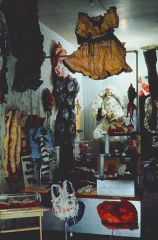
|
Name: The Store Artist: Claes Oldenburg Year: 1961 Description: Oldenburg is reconsidering the idea of medium specificity, commerciality, and the referent of an art work in this piece. It is a commentary on medium specificity and consumer culture. |
|
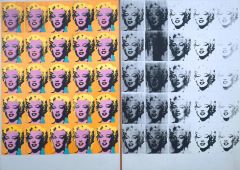
|
Name: Marilyn Diptyque Artist: Andy Warhol Year: 1962 Description: Following Marilyn's death in August 1962, Warhol made over 20 prints of the late star. This piece shows a fascination with two of Warhol's most prevalent themes, death and stardom. The tactile and mechanistic form of silkscreening itself evokes a dynamism between man and the creation of something false: celebritidom. This also seems to show the eternality of life of a star, which is contrasting with the fading prints which reflect a looming mortality. |
|

|
Name: 18 Happenings in 6 Parts Artist: Allan Kaprow Year: 1959 Description: This piece has a goal to dematerialize art and question authorship of art. Each audience member is given a role to fulfill. It fully defines the locus of art as being the relationship between the viewer and the piece rather than it solely residing in the piece. |
|
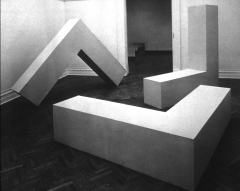
|
Name: Untitled (L Beams) Artist: Robert Morris Year: 1965/66 Description: By placing three identical L beams in a space, Morris is asking us to reconsider the objecthood and independence of a piece of art. These pieces are all the same but become different due to their environment. |
|
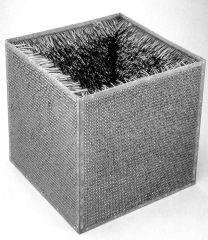
|
Name: Accession I Artist: Eve Hesse Year: 1967 Description: These are metal tubes that have been beat in to the square. There is a tension between organic and geometric forms here. There is an ambiguity of softness and hardness in the piece. |
|
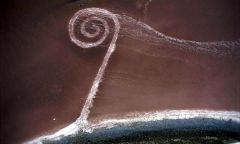
|
Name: Spiral Jetty Artist: Robert Smithson Year: 1970 Description: This piece deals with site specificity. It is dependent on its environment and thought out in terms of it. (red bacteria) It is a manipulation of environment that calls in to question the representation of a landscape. Because it is extremely hard to and cannot be fully seen unless from above, which seems to define it as an artwork for art's being rather than viewer experience. The spiral nature reflects a salt crystalline, which builds up the piece itself and the spiral of film. |
|
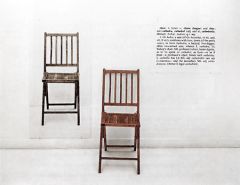
|
Name: One and Three Chairs Artist: Joseph Kosuth Year: 1965 Description: This piece plays with the idea of the materiality of objects and the redefining of the specificity of medium. Kosuth questions the reproducibility of photography in making it completely dependent on its environment. Similarly, the chair itself holds the same restrictions, emphasizing the idea and its manifestation as the crux of an artwork. A banal subject is used to show how communication can occur in life. There is also a dematerialization of the referent, as no object of the three holds priority. Lastly, this calls into question authorship, making a distinction between authorial intent and authorial production. |
|

|
Name: Shapolsky et al., Manhattan Real Estate Holdings, A Real-Time Social System,as of May 1, 1971 Artist: Hans Haacke Year: 1971 Description: Haacke's piece shows a step in conceptual art, moving aware from any sense of traditional representation. It documents the holdings of one Manhattan Real Estate company, exposing the corruption of the relationship between slumlord and tenant. Through photographs, sheets of data, and maps, the piece exposes the unethical tactics of the corporation. This piece exudes a sense claustrophobia upon its audience, as they are quite literally put in the middle of the piece. |
|
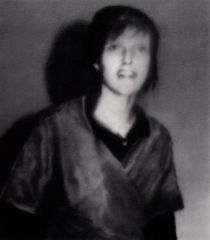
|
Name: October 18, 1977: Confrontation I Artist: Gerhard Richter Year: 1971 Description: Richter's painting shows a confusion of medium and strong leaning on the concept of film and movement to achieve a successful composition. Additionally, with the cropping of the image, the audience is forced to be confronted with the human that is Gudrun Esslin, forgoing her definition as a terrorist for but a moment. |
|
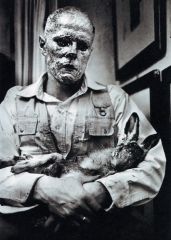
|
Name: How to Explain Pictures to a Dead Hare Artist: Joseph Beuys Year: 1965 Description: This piece questions the locus of art. Beuys explores the idea of a new definition of art, by trying to literally explain art itself. The hare could be a representation of man, the honey knowledge, our reproduction. |
|
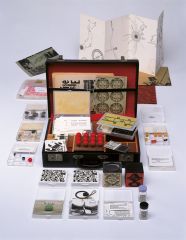
|
Name: Fluxkit Artist: NA (assembled by Maciunas) Year: 1966 Description: This pieces reflects the function of a modern day of the month club, in which one could pay to have this sent to you every month. This piece more than anything shows the organization of an art movement. It is commentary on the idea of commodity, consumption, and distribution. Its goal is to make art accessible at a lower price. |
|
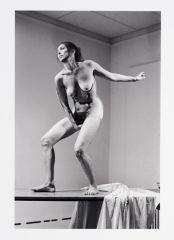
|
Name: Interior Scroll Artist: Carolee Schneemann Year: 1975 Description: This was a performance piece in which she outlined her body in black paint and read from a mythical biography she wrote in which she envisioned Cezanne as a woman and the effects that would have on the art world. After finishing reading her book, she pulled a scroll from her genitals and began to read a poem. In this piece she collapses fetishism, and removes her sexuality by making her ability to reproduce a means of producing creativity and art. She also attacks the idea of traditional women's roles set forth in her readings. |
|
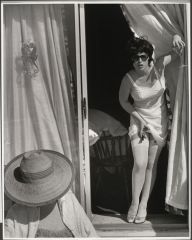
|
Name: Untitled Film Still #7 Artist: Cindy Sherman Year: 1978 Description: This image mimics a traditional publicity still like one would see in an advertisement of a movie. They are all of her assuming another role that projects a stereotype of a woman. Her own identity is removed in her assumption of another role and the medium specificity is lost. This calls into question the idea of authorship, compulsive self-production, and female subjectivity. |
|
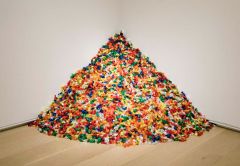
|
Name: Untitled (Portrait of Ross in LA) Artist: Felix Gonzalez-Torres Year: 1991 Description: This piece is comprised of multicolored candies. There are enough pieces of candy to equal 175 lbs, the ideal weight of Gonzalez-Torres's partner Ross who died of an aids related illness. The audience is encouraged to take a piece of candy, as the museum constantly replenishes them to keep a constant weight, reflecting an eternality of life. This is contrasted with the fact that the candy itself is no longer manufactured and thus the piece will have an eventual end. |

